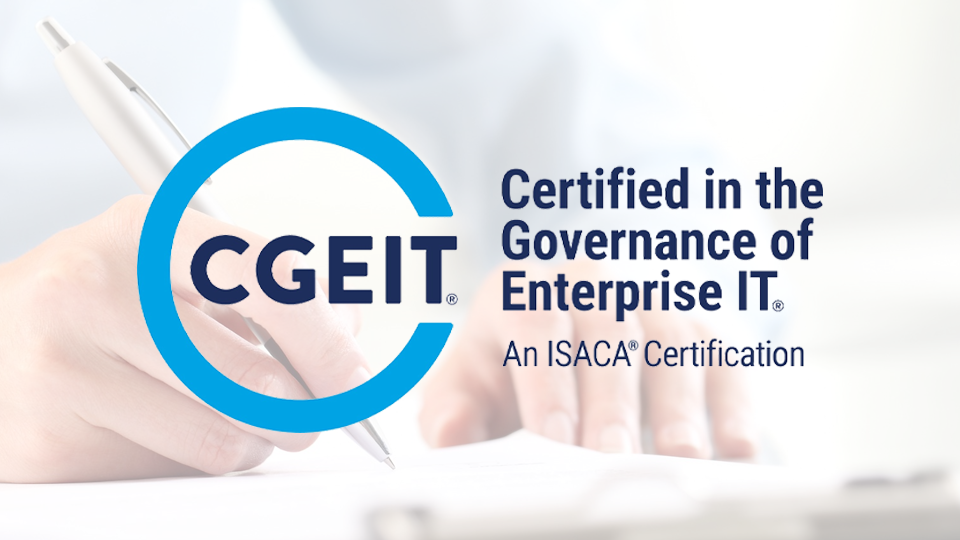
IT governance is at the heart of any successful organization in today’s digital world. However, with the rapid pace of technological change, many entities struggle to keep policies and frameworks up-to-date. This can lead to increased risk and compliance issues that threaten to undermine operations. By investing in professional certifications like CGEIT, offered by the globally renowned ISACA, Saudi Arabian government and academic institutions can ensure their IT workforce has the knowledge and skills to drive excellence in IT governance. With focused training on topics from risk optimization to resource management across IT and enterprise goals, employees can become strategic assets. Providing CGEIT certification will demonstrate a commitment to governance, boost institutional cybersecurity, and give professionals the tools needed to excel in IT leadership roles. With strong IT governance, Saudi organizations can confidently navigate the digital future.
The Growing Need for IT Governance

The world of IT governance is evolving rapidly to keep pace with today’s digital landscape. As organizations continue their digital transformation journeys, their risk exposure is expanding. In 2022 alone, publicized data breaches resulted in over 422 million compromised records, a 128 million increase from the previous year.
To address these alarming statistics, organizations require professionals with the skills and knowledge to implement effective IT governance frameworks. The Certified in the Governance of Enterprise IT (CGEIT) certification from ISACA equips professionals with the expertise to do just that. It focuses on four key areas: strategic management, benefit realization, risk optimization, and resource optimization.
Attaining the CGEIT certification demonstrates one’s proficiency in leveraging IT to achieve strategic business goals while balancing risks and resources. CGEIT-certified professionals are well-versed in frameworks like COBIT 2019 and can apply them to strengthen an organization’s IT governance. They can optimize information systems to generate business value, reduce risks around data and systems, and ensure the effective and efficient use of IT resources.
In today’s digital era, data breaches and IT security incidents are frequent occurrences that can be detrimental if not properly governed. Government entities and large organizations in Saudi Arabia would benefit greatly from having CGEIT-certified professionals guiding their IT governance strategies and frameworks. By offering the CGEIT certification course, these organizations can empower their employees with the skills needed to implement robust IT governance practices, enabling digital transformation success while mitigating risks.
Introducing CGEIT Certification
CGEIT certification was introduced in 2007 and has been effective since December 2008. Administered by ISACA, the CGEIT credential validates an individual’s knowledge, skills, and expertise in enterprise IT governance. Professionals who earn the CGEIT recognition have demonstrated their ability to apply this knowledge to help their organizations.
CGEIT is designed for those with at least five years of experience managing, serving or advising on the governance of enterprise IT. To achieve CGEIT status, candidates must pass a rigorous exam covering five domains: IT Governance Framework, Strategic Management, Benefits Realization, Risk Optimization, and Resource Optimization.
Strategic Management

This domain focuses on an organization’s IT strategic planning process. CGEIT professionals should understand how to align IT and business strategies, determine IT strategic objectives, and assess IT strategic options. They should be able to lead the development of strategic IT plans, communicate the strategic direction of IT, and drive the implementation of strategic IT initiatives.
Benefits Realization
This domain is concerned with optimizing the benefits obtained from IT-enabled investments and ensuring stakeholder needs are met. CGEIT professionals need to determine key performance indicators to measure the benefits and value of IT, optimize IT service delivery, manage IT-related business change, and maintain alignment between business and IT objectives.
CGEIT certification can benefit both individuals and organizations. For professionals, it demonstrates mastery of enterprise IT governance knowledge and can lead to career advancement. For organizations, employing CGEIT-certified staff helps to strengthen IT governance practices, optimize resources, and realize maximum benefit from IT investments. By offering the CGEIT course, government entities and companies in Saudi Arabia can empower their IT professionals with the expertise to implement effective IT governance.
Who Should Pursue CGEIT Certification?
Seasoned IT Professionals

The CGEIT certification is designed for professionals with at least five years of experience in IT governance. Candidates should have a broad range of knowledge and skills in areas such as strategic planning, resource optimization, and risk management. The certification allows experienced IT professionals to demonstrate their ability to evaluate and direct the governance of IT at an enterprise level.
Managers and Executives
The CGEIT is also suitable for professionals in managerial and leadership roles, such as IT directors, CIOs, and CISOs. As managers advance in their careers, the CGEIT provides an opportunity to strengthen their knowledge and skills in critical areas like value delivery, risk optimization, and strategic alignment. By pursuing CGEIT certification, managers and executives can gain a competitive advantage and increase their credibility in the field of IT governance.
Compliance and Audit Professionals
For professionals in compliance, audit, and risk management roles, the CGEIT provides relevant education in areas such as compliance and control frameworks, auditing IT governance, and risk optimization. The certification allows compliance and audit professionals to expand their knowledge of IT governance so they can better evaluate governance processes and provide guidance to organizations. By understanding leading practices in IT governance, these professionals can play an important role in helping organizations align IT strategy with business objectives while managing risk.
In summary, the CGEIT certification is ideally suited for IT professionals with several years of experience who want to advance their careers, as well as managers, executives, and compliance professionals looking to strengthen their knowledge and skills in IT governance. By achieving CGEIT certification, individuals in these roles can gain a competitive advantage, increase their credibility, and make a greater impact on the governance of IT in their organizations.
Benefits of CGEIT Certification for Professionals
Career Advancement
Attaining the CGEIT certification provides individuals the opportunity for career growth and advancement. CGEIT certified professionals gain recognition as experts in IT governance, opening up more senior job opportunities with higher compensation. According to ISACA’s 2020 IT Skills and Salary Survey, IT professionals with a CGEIT certification earn a median salary of $134,000 USD in the United States, which is 27% higher than those without a CGEIT.
Increased Knowledge and Expertise
Preparing for and achieving CGEIT certification helps professionals strengthen and expand their IT governance knowledge and skills. To become CGEIT certified, individuals must demonstrate in-depth knowledge of IT governance frameworks, processes, and implementation methodologies. Studying for the CGEIT exam exposes professionals to global best practices in IT governance and helps them stay up-to-date with the latest industry standards and trends.
Improved Job Performance
With an advanced understanding of IT governance principles and practices, CGEIT certified professionals are well equipped to excel in IT and cybersecurity governance roles. They gain insights into how to align IT governance with business objectives, evaluate IT policies and procedures, reduce IT risks, and optimize resource management. Their broad knowledge of global standards, frameworks and processes enables them to effectively assess and improve their organization’s IT governance.
Enhanced Professional Credibility
The CGEIT certification is a respected and globally recognized credential for IT governance professionals. Achieving CGEIT certification demonstrates an individual’s competence, credibility and commitment to the field. It signifies to employers and peers that the certification holder possesses the knowledge, skills and experience to strategically manage IT governance within an enterprise. CGEIT certified professionals are viewed as leaders in championing best practices in IT governance.
In summary, the CGEIT certification provides significant benefits for professionals seeking to advance their careers in IT governance. It opens up opportunities for career growth, helps strengthen knowledge and skills, improves job performance, and enhances professional credibility.
Benefits of CGEIT Certification for Organizations
Organizations that sponsor their IT professionals to obtain the CGEIT certification stand to gain significantly.
Increased productivity
With a stronger understanding of IT governance frameworks and best practices, CGEIT-certified employees are better equipped to make strategic decisions that optimize the value of IT. They can identify and implement improvements to processes and systems, reducing inefficiencies and waste.
Lower risks
Professionals with the CGEIT certification have the knowledge and skills to strengthen an organization’s risk management and compliance stance. They are familiar with laws and regulations such as the GDPR and can help ensure the organization adheres to them. They are also able to evaluate IT systems and controls to identify vulnerabilities and put appropriate safeguards in place.
Improved business systems
CGEIT certification leads to greater awareness of the role that IT governance plays in achieving business objectives. Equipped with this strategic perspective, CGEIT-certified professionals can make recommendations to enhance key business systems and the IT infrastructure as a whole. They take a holistic view of how technology can be leveraged to facilitate business success.
In summary, the CGEIT certification provides substantial benefits for organizations. It produces IT professionals with the expertise to optimize productivity, mitigate risks, and strengthen critical business systems. Government entities, ministries and universities that invest in developing the IT governance knowledge and skills of their staff through the CGEIT certification will gain a significant competitive advantage. The curriculum covers key areas of IT governance, preparing professionals to significantly contribute to both strategic and operational initiatives. Organizations should consider partnering with an accredited training center to provide CGEIT certification courses for their employees.
Overview of CGEIT Exam Content and Requirements
To obtain the CGEIT certification, candidates must pass a comprehensive exam covering key areas of IT governance. The CGEIT exam was developed by ISACA to assess an individual’s knowledge and skills in the field. According to ISACA, the CGEIT certification is designed for those with at least five years of experience in IT governance and management.
Requirements
To sit for the CGEIT exam, applicants must have a minimum of five years of relevant work experience in IT governance. A bachelor’s degree or equivalent and continuous professional development are also recommended. Candidates should also be well-versed in frameworks like COBIT 5, which provides an end-to-end business view of the governance and management of enterprise IT.
Exam Content
The CGEIT exam covers four domains: Domain 1) Governance Framework, which focuses on establishing and maintaining a governance framework; Domain 2) Strategic Management, which focuses on aligning IT goals and enterprise goals; Domain 3) Benefits Realization, which focuses on optimizing resource management and service delivery; and Domain 4) Risk Optimization, which focuses on implementing risk management practices. The exam includes 150 multiple-choice questions to be completed within 4 hours. A score of 450 out of 800 points is needed to pass.
To maintain the CGEIT credential, holders must complete a minimum of 120 hours of continuing professional education every three years and pay an annual maintenance fee. Continuing education ensures CGEIT holders stay up-to-date with best practices in IT governance.
In summary, the CGEIT certification requires significant experience and knowledge in the field of IT governance. By earning and maintaining the CGEIT credential, professionals can demonstrate their competence and enhance their careers. For organizations, employing CGEIT-certified staff helps ensure effective and strategic IT governance.
CGEIT Exam Fees and Scheduling
The Certified in the Governance of Enterprise IT (CGEIT) certification exam has associated fees for both ISACA members and non-members. ISACA members pay $575 USD to sit for the CGEIT exam, while non-members pay $760 USD. These fees cover the cost of developing, administering, and scoring the exam.
Once candidates have registered and paid the exam fee, they can schedule their CGEIT exam appointment. Exam appointments can typically be scheduled as early as 48 hours after registration and payment. However, candidates are advised to schedule their exam appointment at least 30 days in advance to increase the likelihood of getting their preferred testing date and location.
The CGEIT exam is delivered worldwide at Pearson VUE testing centers. Candidates should schedule their exam appointment directly through Pearson VUE. When scheduling the appointment, candidates will need to provide the exam authorization number provided by ISACA upon registration and payment. Candidates have a twelve-month eligibility period to take the CGEIT exam from the date of registration. If a candidate does not take the exam within the twelve-month eligibility period, they will need to re-register and pay the exam fee again.
To prepare for the CGEIT exam, candidates have several options. ISACA offers the CGEIT Review Manual, as well as online review courses and study questions to aid in preparation. Many candidates also find it helpful to form study groups to discuss the CGEIT domains and practice questions. Gaining practical experience by implementing IT governance frameworks and best practices at one’s organization is also valuable.
The CGEIT certification provides credibility and recognition to those in IT governance roles. By earning the CGEIT certification, professionals can demonstrate their competence and skills in this important domain. The CGEIT exam fees and scheduling process are designed to be straightforward so that interested candidates can work towards this prestigious certification.
Preparing for CGEIT Certification Success
Preparation for the CGEIT certification exam is essential for candidates to achieve a passing score. Diligence and strategic planning are required to prepare for the CGEIT exam. Candidates should understand the fundamentals of IT governance and think at an enterprise level.
To prepare, candidates should study the CGEIT review manual and take practice questions to become familiar with the format and content of the actual CGEIT exam. The review course provides an overview of the core competencies: strategic management, benefit realization, risk optimization, and resource optimization. Candidates should understand how these competencies work together to achieve optimal IT governance.
CGEIT candidates should also participate in group study or join online forums to discuss challenging concepts. Discussing governance issues with others reinforces learning and exposes candidates to new perspectives. Candidates can also consider working with a mentor who has passed the CGEIT exam.
In addition to studying technical content, CGEIT candidates need to prepare for the exam format. The CGEIT exam has 150 multiple-choice questions with four possible answers. Candidates have four hours to complete the exam, so time management and pacing are important. Candidates should practice by taking mock exams under timed conditions.
With diligent preparation and strategic planning, CGEIT candidates can feel confident in their ability to pass the certification exam. Passing the CGEIT exam demonstrates candidates’ knowledge, skills, and abilities in managing IT governance to optimize strategies and objectives. The CGEIT certification brings credibility and recognition to those who achieve it. With hard work and persistence, the CGEIT certification is within the reach of all serious candidates.
CGEIT Training and Exam Prep FAQs
To achieve the CGEIT certification, candidates must meet the necessary requirements and pass a rigorous exam. The CGEIT exam tests candidates’ knowledge and skills across four core areas of IT governance:
Framework, Strategic Management, Risk Optimization, and Resource Optimization. Candidates who prepare properly for the exam and certification process significantly increase their chances of success.
The CGEIT exam has 150 multiple-choice questions that must be completed within 4 hours. Candidates must receive a passing score of 450 out of a possible 800 points to earn the CGEIT certification. Thorough preparation and study of the CGEIT Review Manual and CGEIT Question Bank, both available from ISACA, are strongly recommended.
ES Learning, an accredited training center in Saudi Arabia, provides a CGEIT training course to help candidates prepare for the exam. The 3-day instructor-led course covers the core concepts and topics in the CGEIT Review Manual in depth. Knowledgeable instructors explain the concepts and frameworks, provide examples and case studies, and give candidates the opportunity to ask questions to clarify their understanding.
Hands-on activities and practice questions help reinforce key ideas and familiarize candidates with the format and style of questions on the actual CGEIT exam. The course also provides effective test-taking strategies to improve candidates’ confidence and performance during the exam.
For those interested in group or private on-site CGEIT training for their departments’ employees, ES Learning offers customized solutions tailored to specific needs and learning objectives. Their expert instructors can deliver the course at the client’s chosen location and preferred schedule.
Preparing properly for the CGEIT exam through accredited training and making use of the latest ISACA review materials gives candidates the knowledge and skills to achieve excellence in IT governance. The CGEIT certification signifies competence and expertise, opening up career opportunities and advancement. Government entities, ministries and universities in Saudi Arabia would benefit greatly from sponsoring their IT, Cybersecurity and GRC professionals to undertake CGEIT training and certification.
Conclusion
As highlighted, the CGEIT certification from ISACA provides numerous benefits for both individuals and organizations seeking to enhance IT governance. By developing knowledge across a range of critical domains from risk management to control optimization, CGEIT-certified professionals gain the expertise to drive strategic alignment and deliver value. With demand growing for qualified leaders in IT governance, Saudi Arabian entities would do well to invest in training programs like those offered by ES Learning. Providing CGEIT certification courses to employees in IT, cybersecurity and GRC not only boosts their skills but elevates governance capabilities across the organization. The path to IT excellence starts with empowering professionals – and CGEIT provides a proven way forward.


